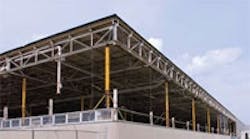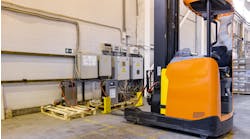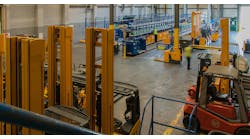When it’s time to grow and you don’t want to go, an increasingly popular way to get a larger building is to pop the top. Brian Holroyd, vice president of Rooflifters, Toronto, Ontario, says commercial property values and other financial forces are going through the roof.
“Reusing a building is nothing new,” says Holroyd. “What we do actually increases the value of the asset— the building—which is what people are looking to do these days.”
When it comes to warehousing, next to location, building height can be a limiting factor of site selection. Holroyd says there’s money to be saved in reusing or selecting a building with a favorable geographic location yet a limiting height.
“Rehabil-
itating a building by raising the roof height, expanding vertically rather than horizontally,” he says, “can cost, typically, as little as $15 per square foot for a 100,000-square foot building.”
As an example, he cites Canada’s largest distributor of candy and snack foods, Planter’s Peanuts in Toronto. “The company was faced with the costly prospect of constructing a new, taller warehouse next door,” says Holroyd, “then tearing down the older, outmoded building.”
Instead, the company decided to expand upward rather than outward. It raised the existing roof of its 70,000- square foot warehouse by jacking up the entire roof to achieve the 16 additional feet it needed to accommodate its modern multi-story material handling system. Holroyd estimates the company saved approximately 40% in construction costs, while more than doubling the facility’s useable area from 1,120,000 cubic feet to 2,240,000 cubic feet in just six months.
How it Works
To hear Holroyd explain the process, it seems like a simple thing just to jack the roof up and put a new one in place. Easier said than done.
“We have a patented process,” he explains, “that transfers the existing roof load onto specially designed hydraulic equipment placed underneath the structural beams of the roof.”
The entire roof is then raised to the desired height and held there while the wall structure is strengthened and built up to the new height. New structural columns are built, and the mechanical, lighting, and HVAC systems are reconnected.
During the actual raising, the Rooflifters’ system is able to synchronize the lifting of each point with tolerances as low as one-eighth of an inch, so that there are no stresses or damage to the existing roof structure, thus maintaining full structural integrity. All work is done under the roof, inside the building. Rooflifters is able to raise roof areas of up to 150,000 square feet at one time, and larger areas can be done in phases. The building can even be used during the process, although the working section has to be vacated.
Reuse and Sustainability
In addition to saving time and reducing costs compared to conventional alternatives, such as demolition, reconstruction, or new construction, this technology offers significant environmental benefits:
• The original building is reused instead of being demolished;
• The expansion of a property is upward, so no virgin land is compromised;
• There is minimum disruption to the locality during the construction process;
• Ninety percent of existing materials are reused or recycled in the process, thus minimizing the use of valuable natural resources;
• There is little or no waste product to dispose of, therefore no adding to landfills.
Holroyd says there are government incentives in many areas for this kind of building use and reuse. “Investors, owners and businesses that are outgrowing their present facility should also be aware of local, state and federal programs that offer incentives to rehabilitate existing industrial structures and reuse industrial buildings vacant for at least two years,” he says.
In some areas of Chicago, for instance, programs entitle properties to a reduced rate of assessment for up to 10 years. Rehabilitating older buildings may also qualify owners for tax deductions of a percentage of construction costs.
To date, Rooflifters has raised more than six million square feet of low-height roofs across North America. For more information, visit www.rooflifters.com.



